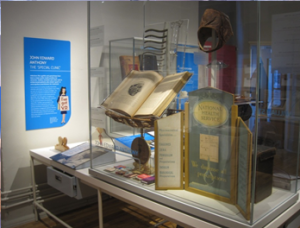A Guest Blog by Louise Price the Curator of the George Marshall Museum, Worcester.
Worcester is lucky to house a 10,000-strong item collection of medical artefacts and two small medical exhibitions reflecting the changes in medicine and healthcare since before the founding of the British Medical Association in the city in 1832. Visitors to the George Marshall Medical Museum learn about the changes in individual specialisms within medicine and healthcare, including Nursing & Midwifery, Surgery, Dentistry and Endoscopy, to name just a few. At The Infirmary, based at University of Worcester, visitors engage in the history of one of England’s oldest infirmaries in its original Georgian setting of the former Worcester Royal Infirmary and the characters who worked there to help so many lives loved and lost.

Entrance to the George Marshall Medical Museum
The Infirmary museum gallery
Both museums display a proportion of the collections held by the George Marshall Medical Museum, housed in a centre for medical education on the campus of the current Worcestershire Royal Hospital. As for most medical museums, the collection is often a little shocking; by definition, it deals with life and death, and there is usually pain (particularly before anaesthetics were invented!). The exhibitions’ aims to share the stories of developments in medicine and healthcare, but also for visitors to leave thankful that they were born in more recent times! For those born before the days of the National Health Service, there are even a few artefacts which can help us to piece together, if only in a small way, what life could have been like for members of the public who were working out their own place in the new system and how they were to gain access to drugs and healthcare at times of sickness.
One such item, currently on display at The Infirmary, is a beautiful NHS prescription notice board, pictured here on display next to a set of baby weighing scales and a terrific atlas of skin diseases!
This board is on a long-term loan from a retired Worcester Anaesthetist, who works closely with the George Marshall Medical Museum. It would have once stood in the window or counter of a small chemist’s, who were eager to show to their existing and prospective customers that they could indeed hand in their GP-signed prescription note to that particular chemist to be given their prescription at a subsidised rate. This board is a rare object in the museums, which helps to show the relationship between customer and supplier at a changing time for all, and shows the important extra step from the NHS pamphlet government ‘circular’, pictured here, which explained to members of the public “rich or poor, man, woman or child” what the NHS was and how they “got it”.
The NHS Prescription Board on display at The Infirmary
For more information about Worcester’s medical museums, visit www.medicalmuseum.org.uk


